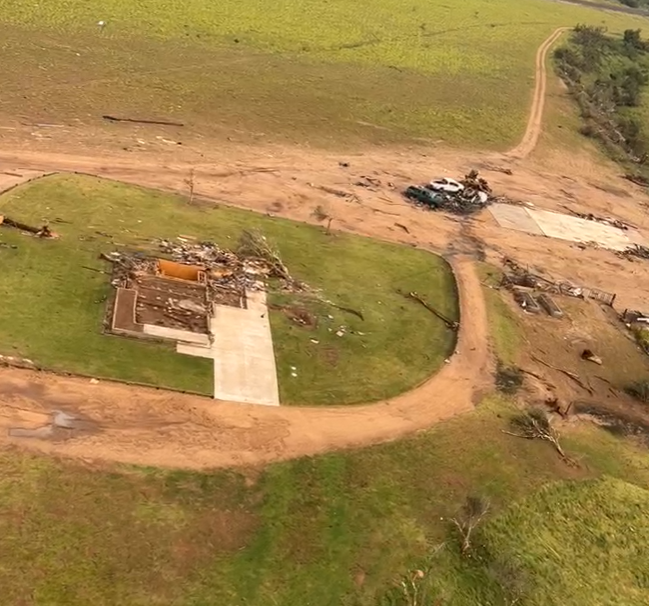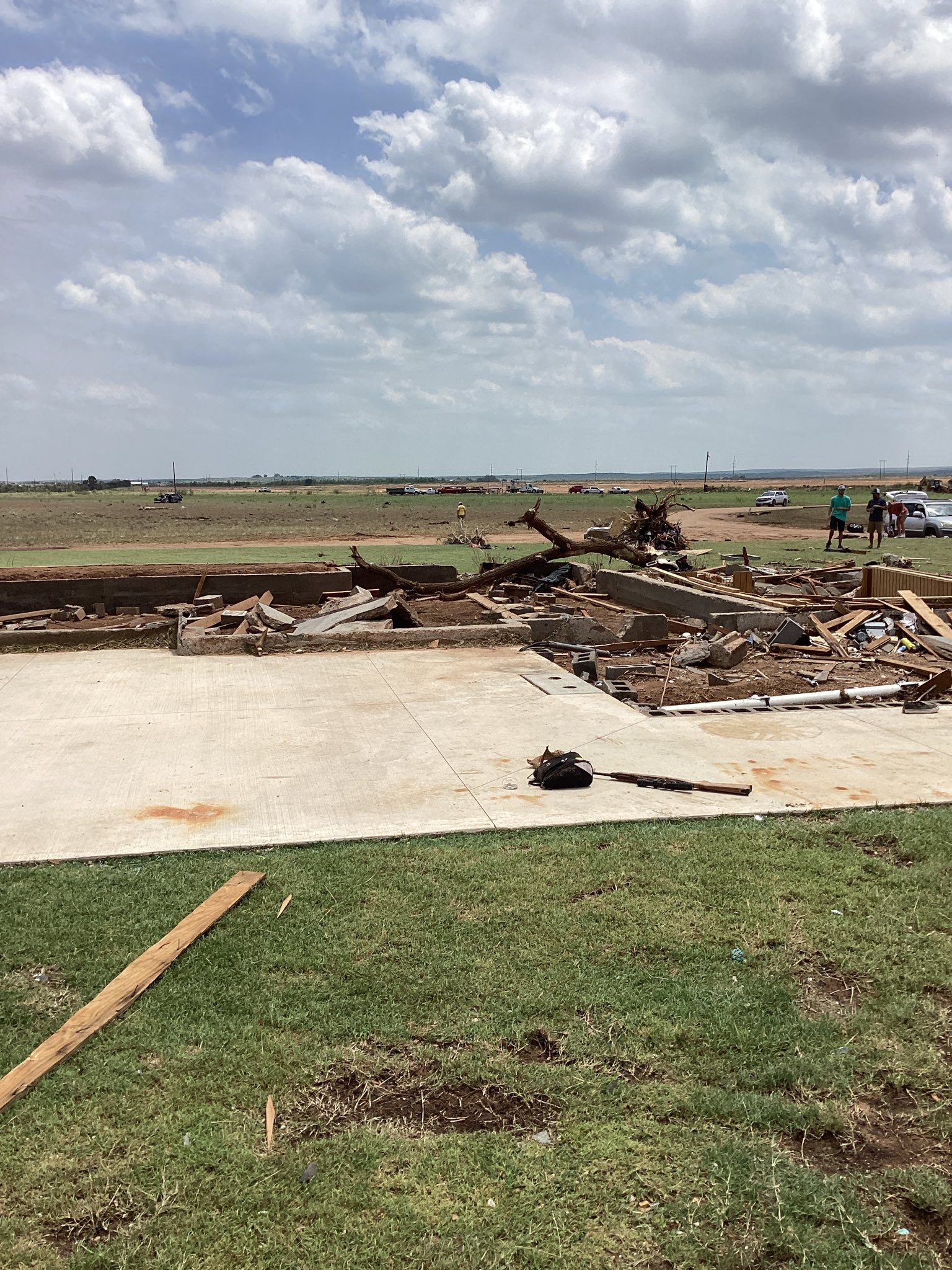I've seen photos of some pretty intense scouring and tree damage that I believe were taken in the same general area. I don't have them in my folder for this event for some reason, but I'll see if I can track them down again. It might not be at the top of any "most violent" list, but there's no doubt it was extremely intense. Pretty fortunate that the tornado was so visible and there was plenty of warning time, otherwise it could have turned into a much greater disaster.
Also, I'm not done yet, but I figured I'd share my progress on creating a new map for the Enigma outbreak. I've done a lot of research and plotted out probably a couple hundred damage points to put the tracks together; I'm sure they aren't perfectly accurate, but I think it's about as close as I can get given how much time has passed. I've only plotted out tracks that I'm pretty certain are from tornadoes, but there are probably a dozen or more others that may have been either weaker tornadoes, downbursts or some combination of both. I may be adding more tornadoes as I do more research. They're color-coded by rating, with green = F1, yellow = F2, light orange = F3, darker orange = F4, red = F5. The gray ones are tornadoes that were not rated by Grazulis.
Speaking of ratings, it's kind of a tricky thing. Obviously Grazulis is the go-to here, and for good reason, but with basically no photographic evidence (at least as far as I'm aware), it's very much open to interpretation. I don't know how much research Grazulis did for each individual tornado, but I put a lot of work into it and I've come to disagree with a number of his ratings based on the available newspaper and eyewitness accounts. 'Course, I'm not exactly an expert, so take that for whatever it's worth. Anyway, what I've done is make two maps, one with Grazulis' ratings and one with my own. So in any event, here are the details so far:
Grazulis Ratings
F5: 0
F4: 4
F3: 9
F2: 24
F1: 0
F?: 24
Total: 61
My Ratings
F5: 3
F4: 7
F3: 17
F2: 30
F1: 4
F?: 0
Total: 61
Here's the Grazulis map:
And here's my map:
Three F5s may seem a little much, but I think there's pretty convincing evidence in each case. Here's a look at each one.
Leeds, AL: I've always felt this was probably an F5, and I've come away only more convinced after more research. According to reports, it was somewhere around half a mile wide and I've measured the path at ~41 miles. In and around Leeds, several dozen homes - some of them of "the finest brick construction" - were completely swept away. One report indicates that some of the foundations were torn from the ground and tossed, though that seems a little hard to believe. Over a dozen people were killed, including a family of three who were thrown several hundred yards and stripped of their clothing. Near Karr Gap, a "comfortable residence" was torn completely off its foundation and blasted to pieces, and what seems to be pretty extensive ground scouring was observed. One news report said: "There is not a plank that belonged to this residence six feet long but what is shivered into splinters, and five or six inches of the top of the earth near the home was blown away." Scraps of paper from this general area reportedly rained from the sky as far away as Chattanooga, TN ~120 miles to the northeast.
Piedmont, AL - Cave Spring, GA: About one mile wide at its most intense with a path approx. 45 miles long. Caused incredibly intense damage north of Piedmont, near the areas of Cross Plains, Goshen and Rock Run. Eyewitnesses mention old, large cedar trees twisted, torn out by the roots and thrown considerable distances (all the more impressive since cedar trees tend to have deep, wide root systems) and large swaths of trees "stripped naked." One witness said that "every home was blown away, even down to the sills," and another said that every home in the path was "swept as clean as a floor." At least two dozen people were killed within a span of less than ten miles, with several victims thrown hundreds of yards and badly mangled. Across the Georgia border near Cave Spring, at least half a dozen stately homes were swept completely away with "little remaining to indicate human habitation."
Rockingham, NC: In my opinion, almost certainly the strongest tornado ever documented in North Carolina and the best candidate to be the state's only F5. Between three-quarters and one mile wide, I have the path at roughly 48 miles. Many homes were completely swept away and torn to pieces in the area around Rockingham, as were two large grist mills. A brick home was blown away with "not one brick left attached to another." About ten people were killed in the area. Just to the northeast, in the predominantly African American village of Philadelphia, 25 of the approximately 30 homes were "wiped off the face of the earth" and somewhere between 15 and 30 people were killed. Horses from a farm near here were reportedly thrown one to two miles. The railroad depot near the village was completely razed. To put it in perspective, a man who visited Grinnell, IA, shortly after the F5 (also incredibly violent) struck there in 1882 said that the damage near Rockingham was "far more terrible."
I also considered the Maynard - Milledgeville, GA tornado for F5 (even though Grazulis somehow only has it rated F3), but decided against it. This long-tracked multivortex tornado caused widespread damage (blowing away a couple large homes and a store north of Clinton, leaving an intense swath of tree damage through much of eastern Monroe and western Jones County, etc.), but was most intense near Blountsville. A large plantation home and several other buildings were "blown to atoms" and scattered for several miles. The wife of the plantation owner and her three children were thrown up to half a mile from the home and badly mangled, and at least six other people were also thrown great distances and killed. One was unfortunately a young infant who was "never found," at least as late as February 29, which was the last update I found. Large hardwood trees were reportedly "reduced to gnarled stumps," the bark stripped and the limbs torn away and "smashed into tooth-picks."











